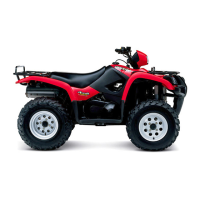• Inflate the
tire
to seat the
tire
bead.
ESSJ
Maximum tire bead
seat
pressure
Front:
250 kPa (2.5 kgf/cm
2
,36 psi)
Rear:
250 kPa (2.5 kgf/cm
2
,36 psi)
A
CAUTION
Place
the tire under a protective tire cage or similar
protective covering device before inflating the tire. To
minimize the possibility of tire damage when seating
the tire bead, never exceed the
MAXIMUM
TIRE
BEAD
SEAT
PRESSURE
rating shown on the tire.
NOTE:
Check
the "rim line" ©
cast
on the tire
side
walls. It must be
equidistant
from the
wheel
rim all the way around. If the
dis-
tance
between
the rim line and the
wheel
rim
varies
this indi-
cates
that the
bead
is not properly
seated.
If this is so, deflate
the
tire completely, and
unseat
the tire
bead
on both
sides.
Then,
coat the
bead
with
clean
water, and
re-seat
the tire.
• Adjust the
tire
pressure to
specification.
ESSJCold
inflation tire
pressure
Front:
35 kPa (0.35 kgf/cm
2
,5.1 psi)
Rear:
30 kPa (0.30 kgf/cm
2
,4.4 psi)
E5SGS
Vehicle
load
capacity:
172 kg (380 lbs)
A
CAUTIOINT
Before
inflating the tire,
check
the
MAXIMUM
OPER-
ATING
PRESSURE
rating of the tire.
This
is indicated
by a following the tire
size
shown on the sidewall.
The
number of on the tire indicates the maximum
operating
pressure.
ESSSJ
Maximum operating
pressure
^:
25 kPa (0.25 kgf/cm
2
,3.6 psi)
35 kPa (0.35 kgf/cm
2
,5.1 psi)
45 kPa (0.45 kgf/cm
2
,6.5 psi)

